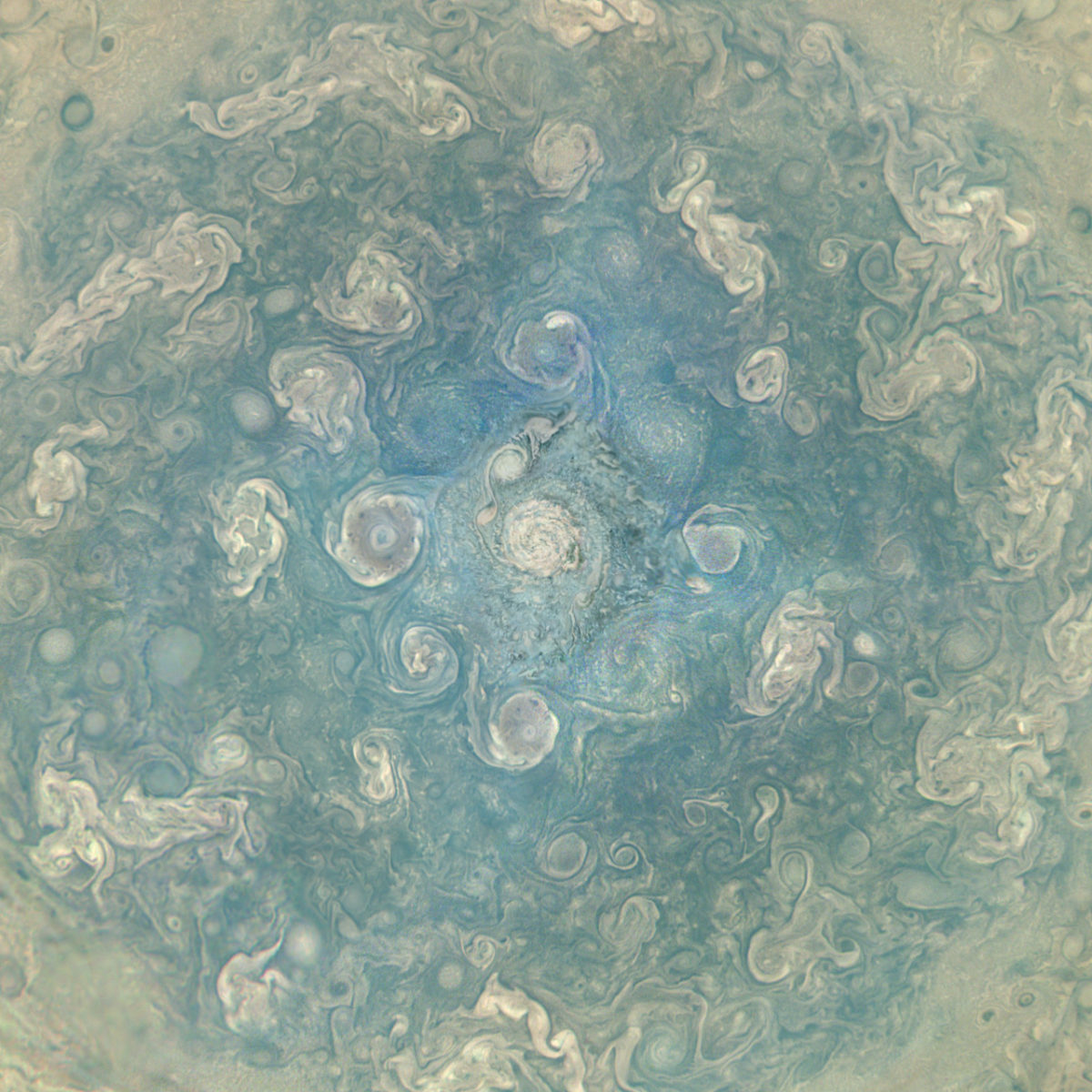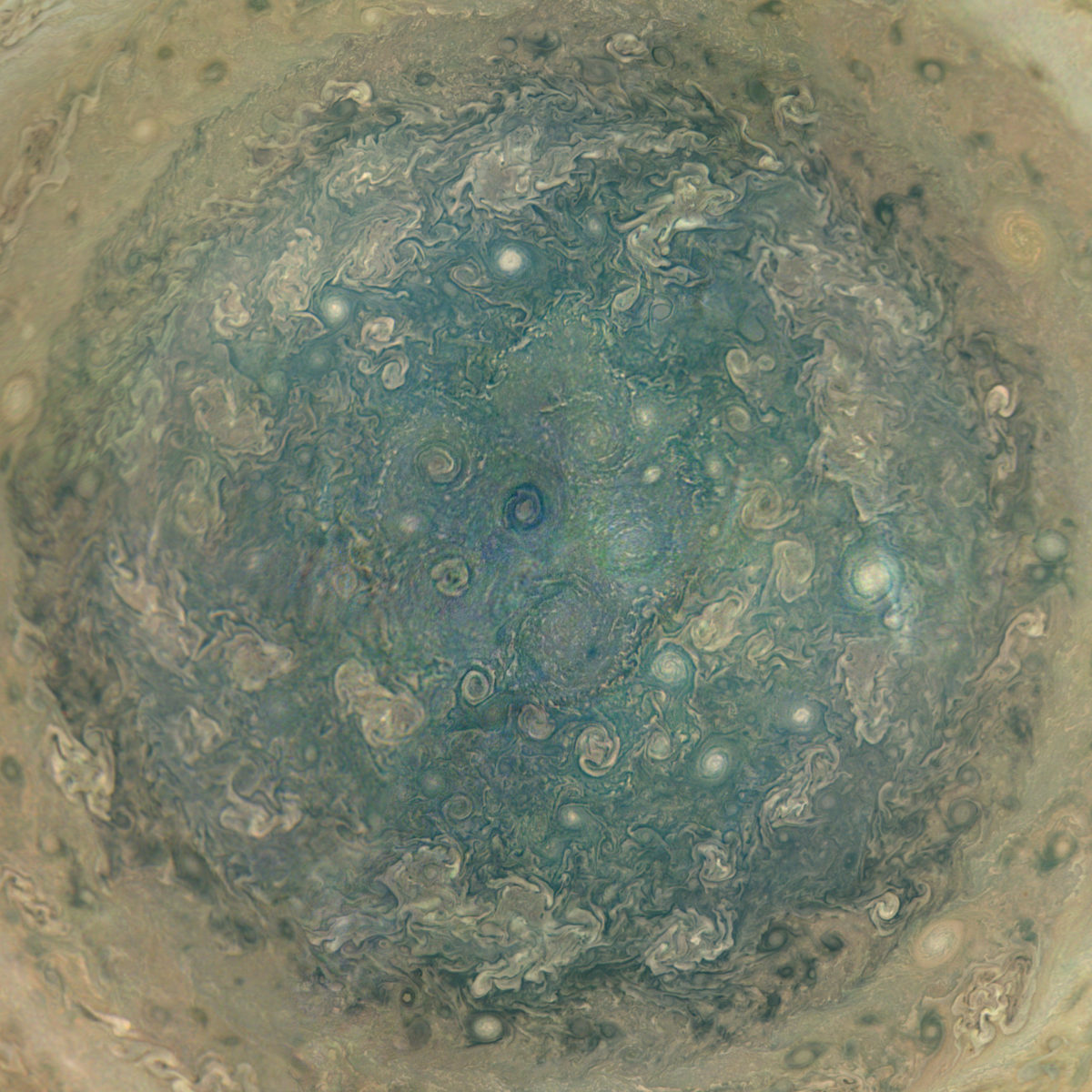Björn Jónsson • Apr 11, 2018
Diving into Juno JIRAM data archives
It is easy to forget that JunoCam isn't the only instrument aboard Juno that can obtain images. The Jovian Infrared Auroral Mapper (JIRAM) instrument can obtain images in two infrared bands. One of these, centered at a wavelength of 4.78 microns, shows thermal radiation emitted from Jupiter. This radiation is caused by heat from Jupiter's warm interior. There is no difference between the dayside and nightside in these images. JIRAM's images are great for looking at Jupiter's north pole, which isn't visible in the JunoCam images because it is currently winter in Jupiter's northern hemisphere.

Each time Juno passes over Jupiter's poles, JIRAM obtains brief time-lapse observations of cloud motions. Here is a tweened time-lapse created from three JIRAM image mosaics obtained over an interval of slightly less than three hours shortly before perijove 4 on February 2, 2017. Because Juno was approaching Jupiter the image sharpness increases from start to finish. If you are unable to play the MP4 file, the time-lapse can also be viewed at Vimeo (the quality is somewhat lower though):
Movie of Jupiter's north pole from Juno JIRAM A time-lapse showing motion near Jupiter's north pole. The time-lapse sequence was created from three mosaics of images obtained by the Jovian Infrared Auroral Mapper (JIRAM) instrument aboard NASA's Juno spacecraft on February 2, 2017. The three mosaics were obtained over a period of a little under 3 hours. During that time the spacecraft was approaching Jupiter and the resolution of the images was getting better. The time-lapse is in orthographic projection and shows the polar area from directly above the north pole. It has been 'tweened' (in effect adding synthetic frames) to make the motion smoother. Because the original video is very short it is looped four times. For full resolution, download the image in MP4 format.Video: NASA / JPL-Caltech / SwRI / ASI / INAF / JIRAM / Björn Jónsson
It is possible to use the JIRAM infrared images to attempt to guess what areas not imaged by JunoCam might look like at visual wavelengths.

This shows all nine circumpolar cyclones (CPCs) in their full glory. The mosaic shows the north polar region from directly above and is in orthographic projection. These images have been processed to show details in the areas that appear very dark in the original images. Comparing JIRAM images to visible light (JunoCam) images reveals that the JIRAM images are somewhat similar to inverted visible light images; features that appear bright at visible wavelength are usually dark in 4.78 µm images and vice versa.
Small-scale details in the cloud morphology should be fairly accurate/realistic but the overall contrast, brightness and color are based partially on a visual comparison of the JunoCam and JIRAM data farther from the pole where useful data from both instruments is available. It is difficult to guess how accurate this is, but it is definitely far better than leaving this area blank!

Upper left: An approximately true color/contrast mosaic of Jupiter's north polar region.
Upper right: A mosaic of Jupiter's north polar region with enhanced colors and contrast.
Lower left: The approximately true color/contrast version with a latitude/longitude grid. Latitudes are planetographic.
Lower right: A diagram showing the areas covered by the different source images/data. Unless otherwise noted the data is from JunoCam.
The JIRAM data appears a bit different from the JunoCam data in the mosaic but this is mainly because the JIRAM images suggest that the overall color and brightness in the area very near the pole (including the central cyclone) really are different from areas farther from the pole. Another factor is that the JIRAM data is of somewhat higher resolution. Also unlike JunoCam, the difficult illumination conditions in the polar region do not affect the JIRAM images.
I created a similar mosaic of the south pole, where I did not need JIRAM to cover the pole.

Usually a spacecraft's highest-resolution imaging instrument is a visible light camera, but Juno is an exception. JIRAM's resolution is higher than JunoCam's. While JIRAM's images are small compared to the JunoCam images (only 432 pixels in the horizontal direction), it has much narrower field of view than JunoCam (5.9 degrees vs. JunoCam's 58 degrees). Combined, this means that the JIRAM images have about three times higher resolution than the JunoCam images, but they also cover a much smaller area.
All of the JIRAM images through perijove 6 are available at the Planetary Data System Atmospheres Node and can be converted to PNG files using IMG2PNG. Thousands of images have been obtained by JIRAM. (Gerald Eichstädt has created some synopses.)
Because JIRAM has obtained so many images, often with an interval of only 30 seconds, they can be animated. Below are two animated GIF examples.


When I processed the images, I decided not to remove noise or make the animations more 'stable'. Both because it would have been a lot of work but also because I actually prefer these animations without 'cleanup'. They appear more realistic that way. This is a matter of taste but sometimes less is more when it comes to image processing.
Here is a third animated GIF from JIRAM images. The source images were obtained during the perijove 5 pass on March 27, 2017. Unlike the other two animations, which I gave a frame rate of 30 frames per second, the frame rate here is 25 frames per second (30 was too fast). The processing is identical to the processing I did in the other two animations above.

Support our core enterprises
Your support powers our mission to explore worlds, find life, and defend Earth. You make all the difference when you make a gift. Give today!
Donate

 Explore Worlds
Explore Worlds Find Life
Find Life Defend Earth
Defend Earth

